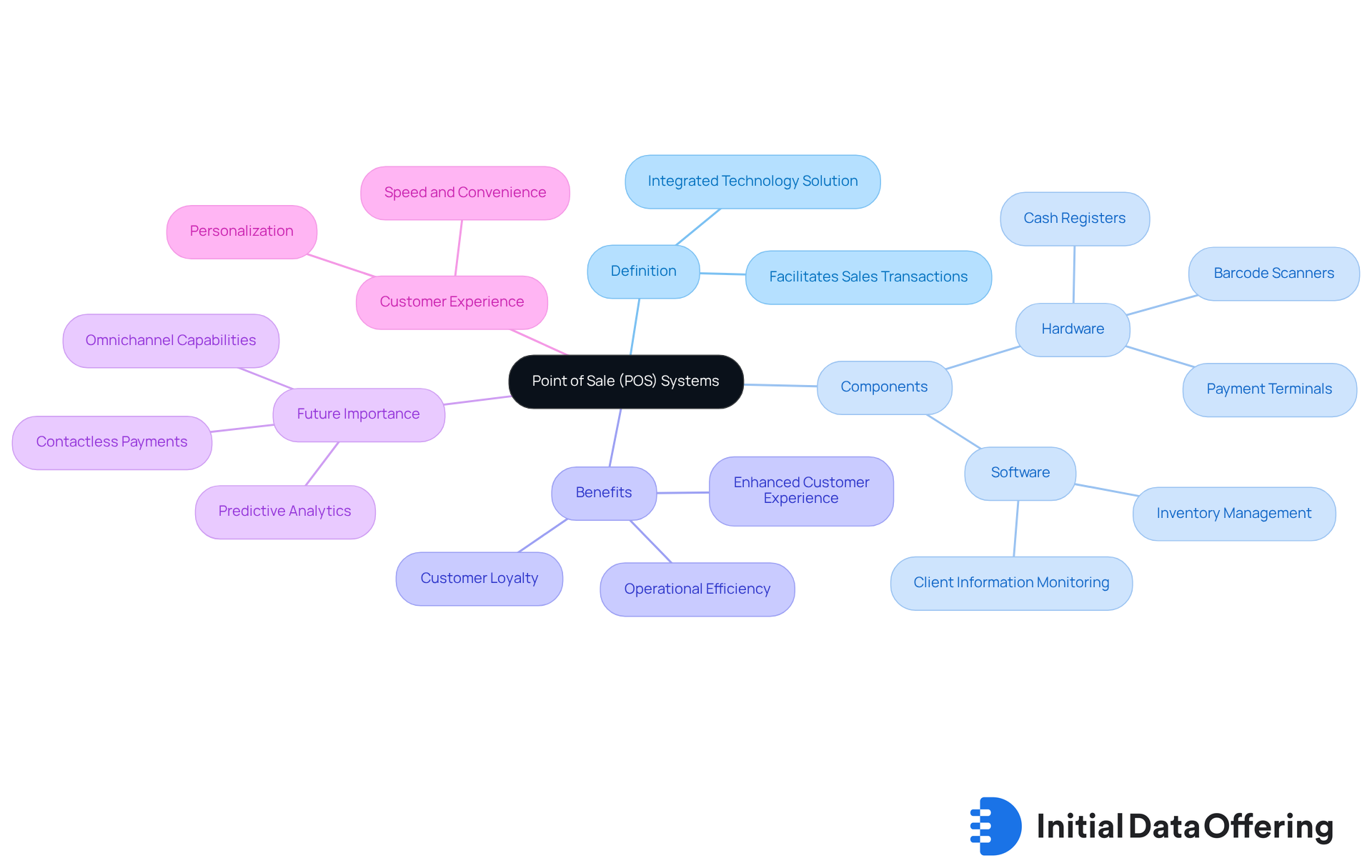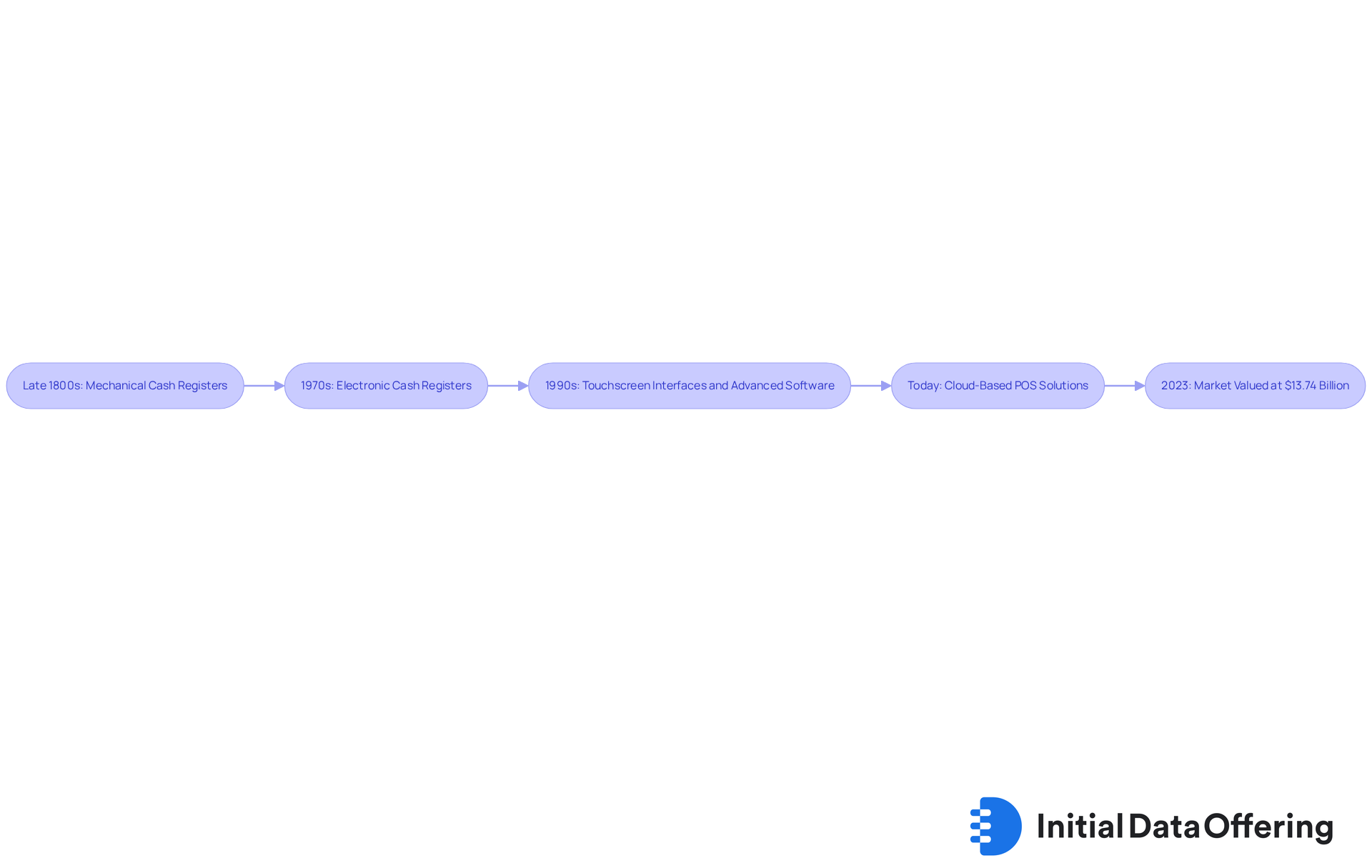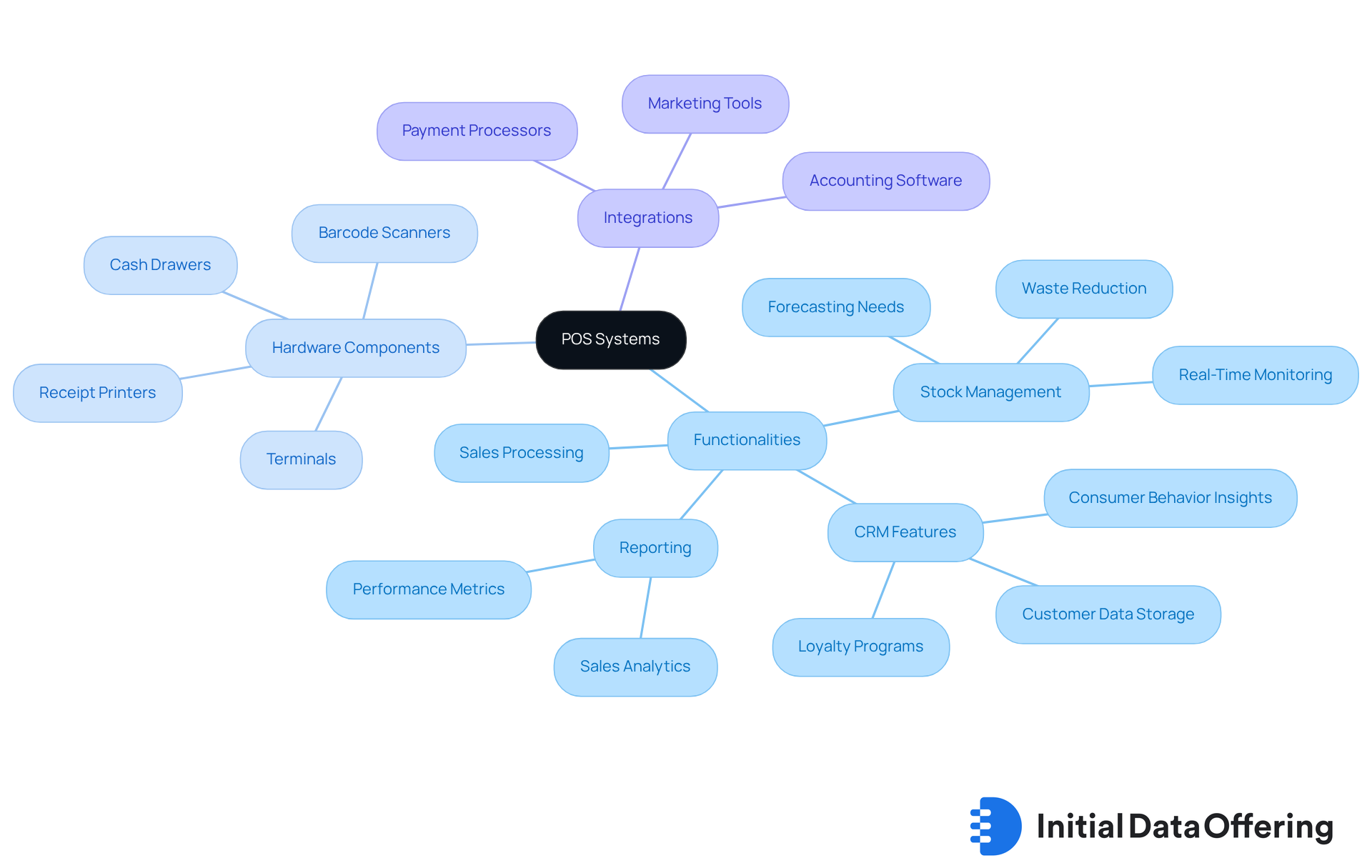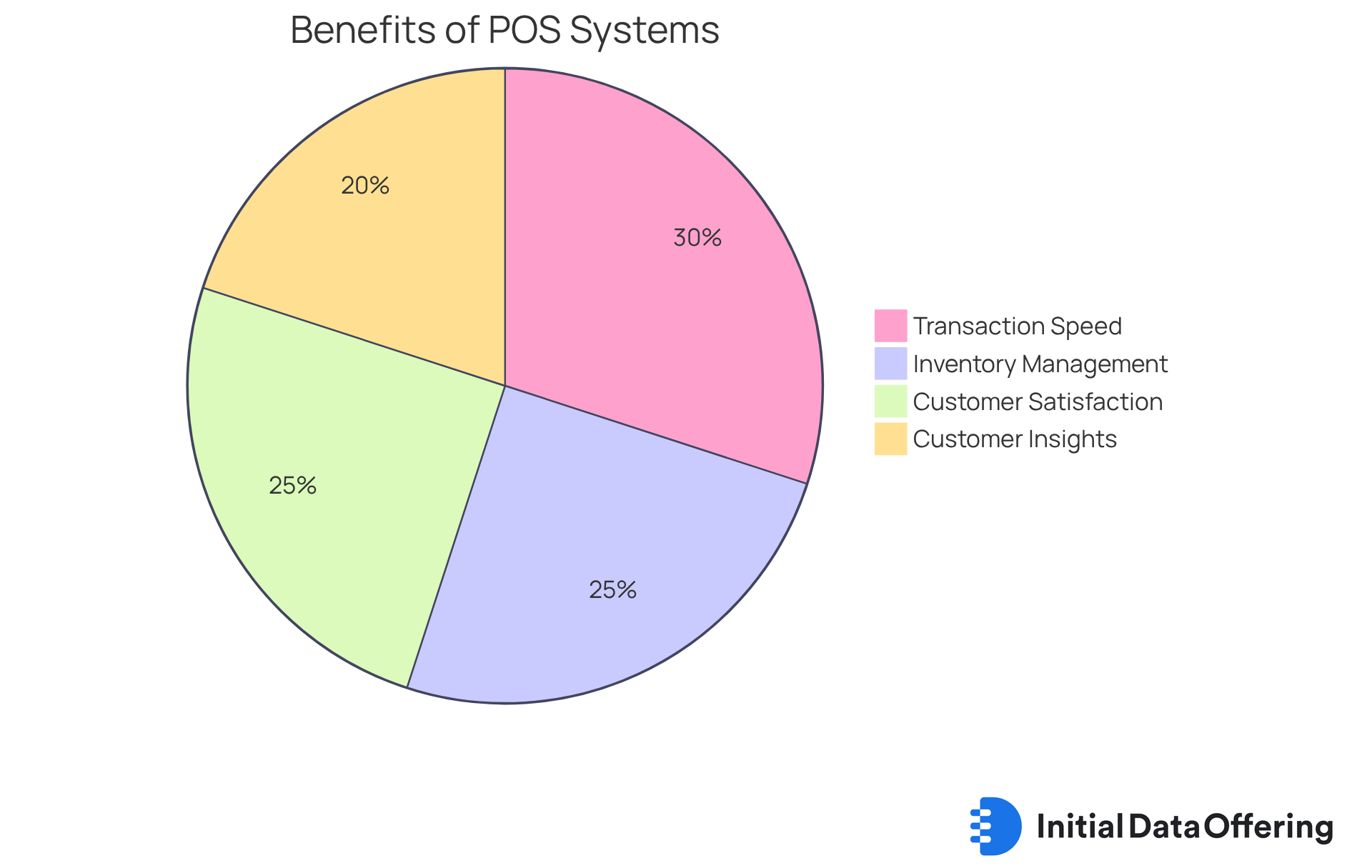What is POS in Retail: Key Features and Benefits Explained

What is POS in Retail: Key Features and Benefits Explained
Overview
The article outlines that a Point of Sale (POS) system in retail serves as an integrated technology solution designed to facilitate sales transactions, manage inventory, and provide customer insights. This system enhances the customer experience and boosts operational efficiency. Key features, such as:
- Real-time stock management
- Advanced analytics
- Seamless integration with e-commerce platforms
collectively drive strategic growth. These elements not only improve customer satisfaction but also enable businesses to thrive in a competitive market.
How can your organization leverage a POS system to optimize its operations and enhance customer interactions?
Introduction
Understanding the intricacies of Point of Sale (POS) systems is essential for retailers aiming to thrive in an increasingly competitive landscape. These integrated technology solutions streamline transactions, enhance customer experiences, and offer benefits that extend far beyond the checkout counter. As businesses navigate the complexities of modern retail, one must consider: how can adopting a contemporary POS system transform operations and elevate customer satisfaction? Exploring the features, advantages, and benefits of these systems reveals their potential to significantly boost growth and efficiency in the retail sector.
Define POS: Understanding Point of Sale Systems
A Point of Sale (POS) setup is an integrated technology solution that enables businesses to facilitate sales transactions efficiently. It combines both hardware and software elements, allowing merchants to handle payments, oversee inventory, and monitor client information effortlessly. The POS platform serves as the central hub for client purchases, incorporating essential components such as cash registers, barcode scanners, and payment terminals.
In 2025, understanding what is POS in retail will be significant, as these solutions greatly enhance client experience and operational efficiency. Contemporary POS systems offer robust analytics, including predictive analytics that assist businesses in anticipating inventory requirements and revealing valuable insights into client behavior and inventory trends. This ultimately fosters strategic growth. As industry experts note, what is POS in retail technology is crucial for meeting the rising expectations of consumers who increasingly prefer speed and convenience in their shopping experiences.
Businesses that leverage advanced POS solutions can streamline operations, reduce wait times, and improve overall service quality. This, in turn, fosters customer loyalty and satisfaction. The incorporation of features such as contactless payments—an essential aspect for contemporary enterprises in 2025—and omnichannel capabilities further illustrates what is POS in retail and how these solutions are reshaping the retail environment. These advancements render POS systems crucial for businesses aiming to succeed in a competitive market.
How can your business benefit from adopting a modern POS system? Consider the potential for improved efficiency and enhanced customer satisfaction as you explore your options.

Trace the Evolution of POS Systems in Retail
The development of point of sale devices began in the late 1800s with the introduction of mechanical cash registers, which revolutionized transaction processing. This initial feature enhanced the efficiency of sales transactions, marking a significant advantage for businesses at the time. Fast forward to the 1970s, a pivotal shift occurred as computers facilitated the creation of electronic cash registers. This advancement not only improved accuracy but also streamlined operations, showcasing the benefits of technology in retail.
By the 1990s, the integration of touchscreen interfaces and advanced software capabilities transformed these solutions into multifunctional tools. These devices now incorporated features such as inventory management and customer relationship management, providing businesses with comprehensive solutions to enhance their operational efficiency. Today, cloud-based point of sale solutions dominate the market. They offer real-time data access, flexibility, and seamless integration with e-commerce platforms, meeting the growing demand for omnichannel retail experiences.
As of 2023, the global POS software market was valued at $13.74 billion, with projections indicating it could reach $42.5 billion by 2027. This reflects a compound annual growth rate of 7.8%, underscoring the increasing reliance on advanced POS systems. Furthermore, 56% of small businesses plan to enhance their POS solutions within the upcoming year, highlighting the continuous evolution in retail technology.
In addition, the mobile POS (mPOS) market is projected to grow to $55 billion by 2024. The use of handheld POS terminals in restaurants has risen significantly, from under 30% in 2017 to 61% in 2022. These trends illustrate the industry's shift towards more adaptable and efficient solutions. How might these developments impact your business operations? Understanding what is pos in retail can help retailers stay competitive and meet customer expectations.

Identify Key Features and Components of POS Systems
Contemporary POS solutions are essential in retail, illustrating what is pos in retail by providing critical functionalities such as sales processing, stock management, relationship management, and comprehensive reporting capabilities. A typical POS setup comprises fundamental hardware components, including terminals, barcode scanners, receipt printers, and cash drawers, paired with software that facilitates transaction management and data analytics. These sophisticated frameworks enhance functionality with mobile payment processing, loyalty program integration, and multi-location management, enabling retailers to streamline operations and improve customer engagement.
The integration of stock management within point-of-sale platforms is vital, allowing companies to monitor supply levels in real-time, reduce waste, and forecast future needs. For instance, EPOS Now's user-friendly stock management features exemplify how effective integration can boost operational efficiency. Furthermore, CRM features within POS platforms aid in client retention by storing valuable information and providing insights into consumer behavior, as illustrated by Clover's loyalty initiative, 'Clover Rewards'.
Industry leaders highlight the significance of these integrations. A CEO noted that efficient stock management is essential for maximizing sales and enhancing client satisfaction. Additionally, the most common hardware components in POS setups—terminals, barcode scanners, and receipt printers—collaborate to ensure smooth transaction processing and stock monitoring. As the retail landscape evolves, knowing what is pos in retail and adopting advanced features will continue to be crucial in driving business success.

Explore the Benefits of Implementing POS Systems in Retail
Introducing a solution that answers what is pos in retail presents numerous advantages, particularly in enhancing transaction speed, optimizing inventory management, and providing deeper insights into customer behavior. Retailers who have adopted advanced point-of-sale technologies report a significant reduction in checkout times, which correlates directly with increased customer satisfaction and loyalty. Research indicates that 85% of shoppers are more likely to return to a store that offers a seamless checkout experience, often made possible through effective POS solutions. Additionally, these systems facilitate valuable data analysis, allowing retailers to efficiently track sales trends and customer preferences. This data-driven approach empowers retailers to make informed decisions regarding inventory and marketing strategies.
Significantly, 43% of retailers experienced a substantial reduction in stockouts and overstock situations following the implementation of a POS solution, underscoring improvements in inventory management. Furthermore, integrating POS technology with e-commerce platforms creates a cohesive omnichannel experience, catering to the evolving needs of modern consumers. Retailers leveraging these capabilities have reported improvements in customer satisfaction, with some noting a 20% increase in returning customers attributable to personalized marketing and loyalty programs.
As Jim Rohn noted, investing in customer support yields long-term financial benefits, further emphasizing the importance of user experience in relation to point-of-sale solutions. Overall, understanding what is pos in retail is crucial for the strategic deployment of systems that boost operational efficiency and customer engagement, especially as these systems increasingly integrate with emerging technologies such as augmented reality (AR) and virtual reality (VR).

Conclusion
A comprehensive understanding of Point of Sale (POS) systems in retail reveals their vital role in enhancing operational efficiency and customer satisfaction. As businesses increasingly adopt these integrated solutions, they streamline sales transactions and leverage advanced analytics to gain insights into consumer behavior and inventory trends. This evolution in retail technology underscores the importance of adopting modern POS systems to meet the growing expectations of consumers for speed and convenience.
Key insights throughout the article highlight the historical progression of POS systems—from mechanical cash registers to sophisticated cloud-based solutions—demonstrating how technology has transformed the retail landscape. The integration of essential features such as inventory management, customer relationship management, and mobile payment processing illustrates the multifaceted benefits that contemporary POS systems offer. Retailers who embrace these technologies are better positioned to enhance customer loyalty, reduce operational costs, and ultimately drive business growth.
In light of these insights, it is crucial for retailers to evaluate their current systems and consider the advantages of upgrading to modern POS solutions. By doing so, they can improve their operational efficiencies and create a more engaging shopping experience for their customers. Embracing the future of retail technology through advanced POS systems is not just an option; it is a strategic necessity for success in an increasingly competitive market.
Frequently Asked Questions
What is a Point of Sale (POS) system?
A Point of Sale (POS) system is an integrated technology solution that enables businesses to facilitate sales transactions efficiently, combining both hardware and software to handle payments, oversee inventory, and monitor client information.
What are the main components of a POS system?
The main components of a POS system include cash registers, barcode scanners, and payment terminals.
How does a modern POS system enhance customer experience?
Modern POS systems enhance customer experience by streamlining operations, reducing wait times, and improving overall service quality, which fosters customer loyalty and satisfaction.
What role do analytics play in contemporary POS systems?
Contemporary POS systems offer robust analytics, including predictive analytics, which assist businesses in anticipating inventory requirements and providing valuable insights into client behavior and inventory trends.
Why is understanding POS systems important for retail businesses in 2025?
Understanding POS systems is important for retail businesses in 2025 because these solutions greatly enhance client experience and operational efficiency, which are crucial for meeting the rising expectations of consumers who prefer speed and convenience.
What features are essential for modern POS systems?
Essential features for modern POS systems include contactless payments and omnichannel capabilities, which are important for contemporary enterprises.
How can businesses benefit from adopting a modern POS system?
Businesses can benefit from adopting a modern POS system through improved efficiency and enhanced customer satisfaction, contributing to strategic growth in a competitive market.